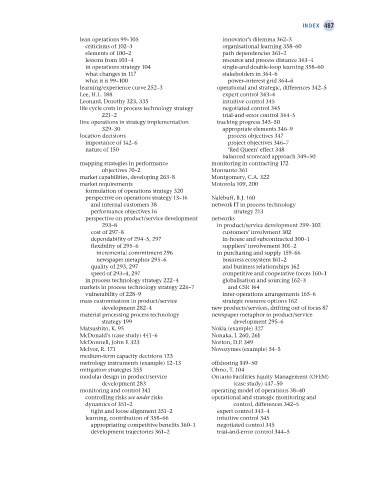Page 512 - Operations Strategy
P. 512
Index 487
lean operations 99–105 innovator’s dilemma 362–3
criticisms of 102–3 organisational learning 358–60
elements of 100–2 path dependencies 361–2
lessons from 103–4 resource and process distance 363–4
in operations strategy 104 single-and double-loop learning 358–60
what changes in 117 stakeholders in 364–6
what it is 99–100 power–interest grid 364–6
learning/experience curve 252–3 operational and strategic, differences 342–5
Lee, H.L. 188 expert control 343–4
Leonard, Dorothy 323, 335 intuitive control 345
life cycle costs in process technology strategy negotiated control 345
221–2 trial-and-error control 344–5
line operations in strategy implementation tracking progress 345–50
329–30 appropriate elements 346–9
location decisions process objectives 347
importance of 142–6 project objectives 346–7
nature of 150 ‘Red Queen’ effect 348
balanced scorecard approach 349–50
mapping strategies in performance monitoring in contracting 172
objectives 70–2 Monsanto 361
market capabilities, developing 263–8 Montgomery, C.A. 322
market requirements Motorola 109, 200
formulation of operations strategy 320
perspective on operations strategy 13–16 Nalebuff, B.J. 160
and internal customers 38 network IT in process technology
performance objectives 16 strategy 213
perspective on product/service development networks
293–8 in product/service development 299–302
cost of 297–8 customers’ involvment 302
dependability of 294–5, 297 in-house and subcontracted 300–1
flexibility of 295–6 suppliers’ involvement 301–2
incremental commitment 296 in purchasing and supply 159–66
newspaper metaphor 295–6 business ecosystem 161–2
quality of 293, 297 and business relationships 162
speed of 293–4, 297 competitive and cooperative forces 160–1
in process technology strategy 222–4 globalisation and sourcing 162–3
markets in process technology strategy 226–7 and CSR 164
vulnerability of 228–9 inter-operations arrangements 165–6
mass customisation in product/service strategic resource options 162
development 282–4 new products/services, drifting out of focus 87
material processing process technology newspaper metaphor in product/service
strategy 199 development 295–6
Matsushito, K. 95 Nokia (example) 327
McDonald’s (case study) 441–6 Nonaka, I. 260, 261
McDonnell, John F. 323 Norton, D.P. 349
McIvor, R. 171 Novozymes (example) 54–5
medium-term capacity decisions 123
metrology instruments (example) 12–13 offshoring 149–50
mitigation strategies 355 Ohno, T. 104
modular design in product/service Ontario Facilities Equity Management (OFEM)
development 283 (case study) 447–50
monitoring and control 341 operating model of operations 38–40
controlling risks see under risks operational and strategic monitoring and
dynamics of 351–2 control, differences 342–5
tight and loose alignment 351–2 expert control 343–4
learning, contribution of 358–66 intuitive control 345
appropriating competitive benefits 360–1 negotiated control 345
development trajectories 361–2 trial-and-error control 344–5
Z20 Operations Strategy 62492.indd 487 09/03/2017 14:48

